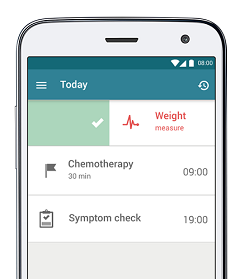Living with Leukemia: An App for Medication Management and Support During Treatment
MyTherapy, a Medication Reminder and Health Tracker App, Helps Patients with Leukemia Manage Their Treatment Plans and Improve Their Quality of Life

Leukemia is a cancer that begins in blood-forming tissue (usually the bone marrow). This leads to the over-production of white blood cells, which are responsible for defending the body against infection. There are several different types of leukemia, and diagnoses are based on how fast the condition progresses and what blood cells are affected. The treatment for each type is different and may include chemotherapy, radiotherapy, biological therapies, or targeted therapies. While the range of treatment options is wide, they all have one thing in common: adherence. When it comes to managing leukemia and treatment, it is crucial that you, the patient, remember to take your medication exactly as it is prescribed and go to doctor’s appointments regularly. However, it can often be difficult to remember these tasks and to keep track of how you are doing. Fortunately, smartphone health and reminder apps can offer valuable support in this area.
MyTherapy was specifically developed for people who suffer from long-term health conditions like leukemia. MyTherapy generates medication reminders, which can help you, the leukemia patient, take your medication on time. For example, if you have been diagnosed with chronic myelogenous leukemia, you may require a daily dose of Gleevec. Or you may take pain medication or anti-sickness medication to cope with the side effects of chemotherapy. MyTherapy generates specific pill reminders telling you when and how (in terms of dosage) to take your medication. Furthermore, MyTherapy can also remind you of upcoming doctor’s appointments, chemotherapy, or radiotherapy sessions.
Apart from the reminder function, MyTherapy also includes a health journal. You can use the health journal to track your symptoms, side-effects of the medication, or important health measurements like weight or blood count. All data that you record in the app can easily be printed out in the form of easy-to-read graphs and shared with your doctor. The doctor can then use it as a tool to gain an overview of the condition and the progress of your treatment plan. The health journal can therefore help you and your doctor understand whether the treatment is working as well as planned and adjust it if necessary.
The team at MyTherapy also takes user-feedback seriously, meaning that the app is always tailored to the needs of its users. The app works for everyone, irrespective of age or type of chronic illness. The app helps you adhere to your treatment regimens and gives you a way to monitor the progression of your condition reliably and effectively. This can help you feel more in control of your health in a time of great uncertainty.
How Does Leukemia Form?
Leukemia is a cancer of the early-forming blood cells. There are several broad categories of blood cells including red blood cells (RBCs), white blood cells (WBCs), and platelets. While leukemia generally affects WBCs, it can begin in other blood cell types. These cells are an important part of the immune system and fight infections and diseases. WBCs are mostly produced in the bone marrow, but certain types are also produced in the lymph nodes, thymus gland, and spleen. In leukemia, the WBCs begin to function abnormally. They divide too quickly and start to crowd out normal cells. This leads to serious problems like anemia, infections, bleeding, and swelling and pain in the lymph nodes or other organs. The long-term outlook for people with leukemia depends on the type and stage of the cancer and the earlier the diagnosis and the faster it is treated, the better the chance of recovery. While leukemia can cause death, mortality rates have been on the decline thanks to ground-breaking research and treatment. Therefore, with the right treatment, the lifespan of patients can be prolonged, and, in many cases, leukemia can be cured.
The Various Types of Leukemia
There are several types of leukemia, which all depend on how fast the cancer progresses and what type of blood cell is affected. Firstly, leukemia may be acute or chronic. Acute leukemia progresses rapidly and requires urgent treatment. Chronic leukemia advances very slowly, and the patient may not experience symptoms for several years. Secondly, leukemia may be lymphocytic (sometimes referred to as “lymphoblastic”) or myelogenous. Lymphocytic leukemia affects the lymphocytes, which are a type of white blood cell. With lymphocytic leukemia, the cancerous cells build up gradually over time, and people do not display symptoms for at least a few years. Myelogenous leukemia affects an early version of myeloid cells, which are responsible for making red blood cells, platelets, and most types of white blood cells (except lymphocytes).
There are thus four main types of leukemia:
- Acute myelogenous leukemia (AML). This type is more common in adults than in children. About 2,600 people are diagnosed with it in the UK each year.
- Acute lymphocytic leukemia (ALL). This type of leukemia mostly occurs in children and is the most common form of cancer in children.
- Chronic myelogenous leukemia (CML). This leukemia can affect any one of any age, but it is more common in people between the ages of 40 and 60. There were 742 new cases of chronic myeloid leukemia in 2015 in the UK.
- Chronic lymphocytic leukemia (CLL). This is the most common type of leukemia among adults over the age of 55. There were 3,709 reported cases of chronic lymphocytic leukemia in the UK in 2015.
In addition, there are also less common types of leukemia (e.g. hairy cell leukemia) and various sub-types of leukemia (e.g. acute promyelocytic leukemia).
Signs and Symptoms
The symptoms of leukemia depend on what type of leukemia a person has. However, there is some overlap between the leukemia types, including:
- Excessive sweating, especially at night
- Weight loss
- Swollen lymph nodes (especially in the neck, under the arm, or in the groin)
- Frequent bleeding from the nose, gum, or rectum
- Tiredness and fatigue
- Frequent bruising
- Serious infections
If leukemia is suspected, the doctor will ask you about your medical history and perform a physical examination. However, to confirm the diagnosis of leukemia, various tests are necessary. For instance, a blood test will help determine the number of RBCs, WBCs, and platelets. Moreover, it is useful to look at the blood under the microscope to check whether the cells have abnormal appearances. Small tissue samples, called biopsies, may be taken from the bone marrow or lymph nodes. These can help determine the type of leukemia and the rate at which it is progressing.
The Risk Factors
Leukemia seems to start from one abnormal cell that multiplies uncontrollably. The reason why this cell becomes abnormal is not known. However, there are various risk factors that increase the chance of leukemia developing. These include:
- Radiation (e.g. previous radiotherapy for another condition)
- Past treatment that weakens the immune system (e.g. chemotherapy, certain medicines)
- Certain genetic diseases (e.g. Down’s syndrome)
- Exposure to certain chemicals (e.g. benzene)
- A family history of leukemia
- Smoking
What Treatment Works?
Treatment for leukemia depends on the type and the stage of the cancer, as well as on individual factors such as the patient’s age, general health, and whether leukemia has been treated before. If a person has acute leukemia, it needs to be treated right away. In the case of chronic leukemia, however, treatment depends on how the patient feels. If there are no symptoms present then specialists usually avoid treatment until a later stage. Irrespective of the type of leukemia, the overall goal of treatment is to destroy the abnormal leukemia cells so that normal cells can form in the bone marrow. Usually treatment includes one or more of the following:
- Chemotherapy. This treatment uses drugs to kill leukemia cells. It is administered in pill form, by injection into a vein, or through a catheter.
- Radiation therapy. This treatment uses high energy radiation to kill leukemia cells.
- Stem cell transplantation. This line of treatment replaces the abnormal blood cell precursors in the bone marrow with healthy cells.
- Biological or immune therapy. This therapy includes treatments that help the immune system recognize and attack the abnormal cancer cells. For example, patients might be given monoclonal antibodies, which are artificial proteins that can identify leukemia cells and assist the body in killing them.
- Targeted therapy. This treatment option uses medicines that take advantage of weaknesses in the cancer cells. For instance, patients with CML will probably be given a drug called Gleevec (imatinib mesylate). This drug blocks a certain cancer gene (the BCR-ABL gene), which prevents CML from progressing. Other drugs that also block the cancer gene include Sprycel (dasatinib) and Tasigna (nilotinib).
In addition to these conventional treatments, new possibilities, like experimental cell therapy, to treat leukemia are constantly being developed. These could offer promising alternatives for patients who do not respond to conventional treatments.
Start MyTherapy for Some Extra Support
Leukemia is a serious and potentially life-threatening condition. Therefore, it is important that you adhere to your treatment regimens as strictly as possible. For this reason, smartpatient developed the app, MyTherapy. The app generates constant reminders that help patients remember their medication and their next chemotherapy cycle or doctor’s appointment. Furthermore, the app includes a built-in health journal. This gives you the possibility to track your symptoms and health measurements (e.g. blood count). The health journal can be a useful tool for both you and your doctors to gain an overview of the cancer, assess whether treatment is working, and adjust the therapy plan if necessary. MyTherapy is developed through user-feedback, meaning that all of its features have been adjusted to meet the needs of patients. The app can benefit any one of any age with any type of leukemia. Therefore, MyTherapy can provide valuable support to patients in times of worry and uncertainty.
Sources
- ###Sources:
- www.cancerresearchuk.org/health-professional/cancer-statistics
- www.nhs.uk/Conditions/Leukaemia-acute-lymphoblastic
- nihseniorhealth.gov/leukemia/whatisleukemia
- www.medicalnewstoday.com/articles
- www.healthline.com/health/leukemia
- www.webmd.com/cancer
- https://www.cancer.org/cancer/leukemia.html
- www.cancer.org/cancer/chronic-lymphocytic-leukemia
- www.cancerresearchuk.org/about-cancer/chronic-lymphocytic-leukaemia-cll
- www.medicinenet.com/leukemia


